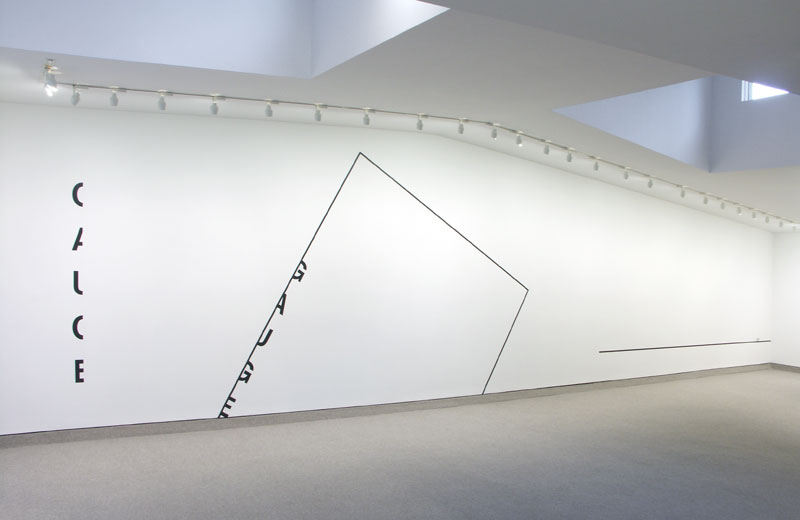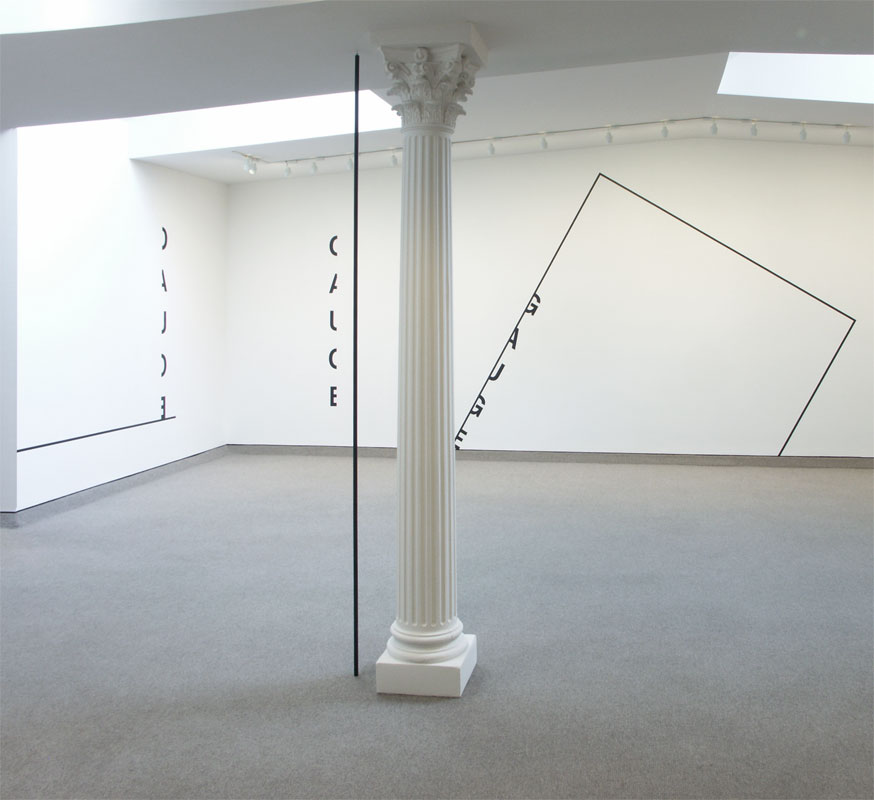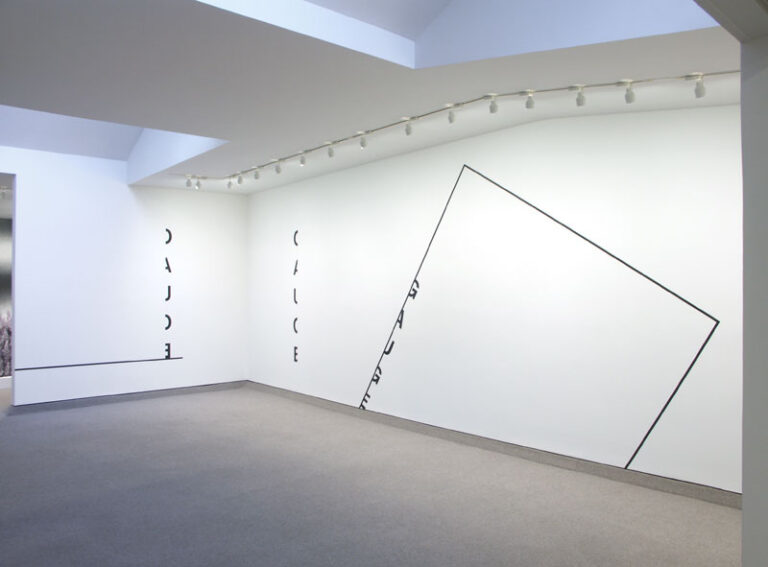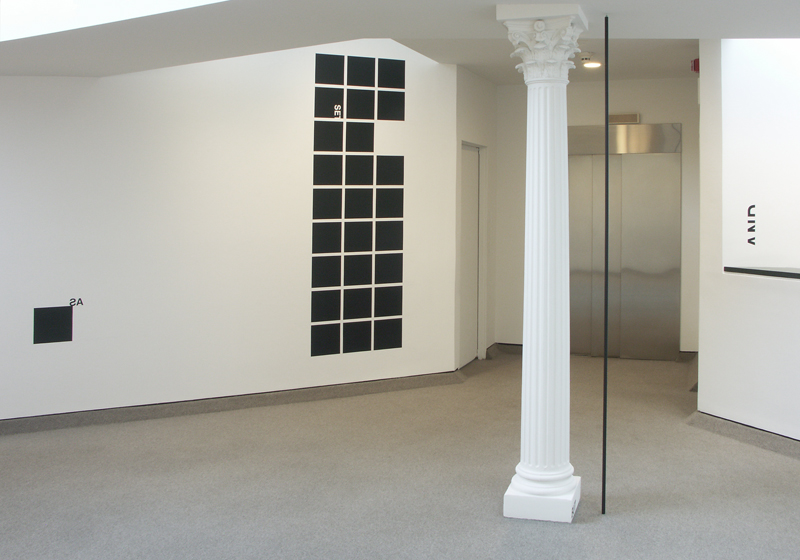
In the early sixties, Peter Downsbrough interrupted his studies in architecture to work as a sculptor. He had his first show in New York in 1971 and by the mid-70’s, the had artist gained international recognition. Throughout the 70’s and 80’s, Peter was consistently invited to participate in exhibitions throughout Europe and so, in 1989, he relocated to Brussels, Belgium. He has continued to show internationally at places such as SMAK, Gent, Belgium, AngelsBarcelona, Barcelona, Spain, Muzeum Sztuki, Lodz, Poland , FRAC Bourgogne, Dijon, France, MAMCO, Genève, Switzerland, Ecole des Beaux-Arts, Nîmes, France, Kunstverein Grafschaft Bentheim, Neuenhaus, Germany, Center for Contemporary Art Ujazdowski Castle, Warsaw, Poland and the Architectural Gallery, Moscow, Russia. In addition, he has had numerous recent film screenings at institutions such as the Centre Pompidou, the Reina Sofia and the Kunsthalle Bern, among others.
As for the art, itself, Downsbrough works with space, time and text. Text is traditionally read. Downsbrough uses text for this, but also makes text ‘work’. Whether the text illustrates what it is that it says or less directly references a relationship to a form in its vicinity, the text becomes an active participant in a viewer’s experience. Normally text ‘works’ for a reader to help one understand information simply by being read. Downsbrough is respectful of this function, but adds to it by having the words demonstrate or converse with the meaning of the words. In the exhibition here at Barbara Krakow Gallery, he focuses on the ideas of measuring and collecting and how one can or can’t do these actions along with a continued exploration of the relevance of comparison, conjunction and separation.
Least obvious when entering the exhibition, but perhaps a good starting place is Downsbrough’s “HERE”, 2009. The piece consists of pipe painted matte black next to vinyl decal lettering (spelling “HERE”) and black fabric tape descending from the last “E” in “HERE”. “Here” is a location that is both specific (to the moment, people, place and context), yet is also relative (as opposed to “there”) much like the black of the three materials and the dimensions of the piece: three different deep blacks are used (tape, vinyl and paint on pipe) and while it locates one place on the wall, each element is not at the same place of ‘here’. The pipe is 3.25 inches to the right of the text and is dimensional (.5 inches in diameter). It extends up, down and out towards the viewer. The tape descends down (or approaches, depending on one’s approach!) from the letters and is, in fact, not a line as the tape has width (.75 inches) as well as length (19.75 inches) and, of course, the letters are not a point, but a two dimensional area (2 x 7.25 inches). So, while “HERE” is a specific location on the wall, it actually is more than one place located by more than one material.
In the large wall piece, “GAUGE, OT”, 2009, Downsbrough semi-masks the phrase, “to gauge” by reversing not only the order of the words, but also reversing one (not both) of the words and mirroring one half of one of the (split down the middle) words. It almost is a math equation, where there is much that is comprehensible but unlike a solvable equation, little adds up to one specific answer. The text almost reads as, “To gauge” (aka to measure), yet there is no way to actually read/prove it (aka measure it), which is much like the world at large – a wonder to behold, but not something that one can encapsulate.
In the middle of Barbara Krakow Gallery is a support column that was encased in a decorative Corinthian column in 1983 when Barbara Krakow Gallery was designed and built. Downsbrough has applied the word, “BUT” to the base of the column along with hanging a black-painted pipe directly next to it, to create the piece, “BUT”, 2009. The pipe looks solidly connected to the floor, but in actuality, hangs from a single eye-hook in the ceiling and just barely grazes the floor so, via gravity, it hangs ‘absolutely upright’. By placing this element directly next to the column, which has entasis (a classical technique of a curved tapering in the column shaft to play with one’s perception of the weight supported by the column), the pipe points to the aesthetic nature of the column as the entasis is visually accentuated. In addition, the pipe provides a ‘true’ directional, which is something missing from virtually every wall in the gallery’s highly irregular space. Added to this juxtaposition is the word, “BUT”, which like many words Downsbrough uses is a conjunction (a word that connects), yet “but” obviously separates, too. Among other characteristics that isolate “BUT” from the rest of the show, the Corinthian column is unlike anything else in the gallery space on account of its classical decoration and the pole is the only piece not attached to a wall, so once again, the text and visual presentation have a direct interplay.
In the piece, “SET, AS (reversed)”, 2009, Downsbrough sets up another visual relationship between space and text. There is a 9 x 3 grid of squares painted in black on the wall, yet the grid is incomplete as there is one square ‘missing’ (the third from the top in the right-most column), as well as an area within the second from the top square in the left-most column that spells out “SET” with the second half of the “T” in “SET” spilling into the border/gridline. The text is not painted on top of the black, but is actually the white of the wall, the same white as the lines that define the grid. The other element of “SET, AS (reversed)” is a single square of black with the word, “AS” reversed sitting at the top right corner of the single square. This square, located several feet to the left of the large grid and at the same height as the second to bottom row of the grid’s squares, hypothetically could ‘complete’ the grid, as the square is the same size, yet it is painted, not in the grid, but near it. To ‘complete’ the grid, the square would have to be repainted, which could be thought of as ‘moving’ the square yet physically that is not what would occur. This relationship between reality, assumptions, imagination and physicality are to what the words “SET” and “AS” can possibly refer. The black squares serve as a set, yet they are ‘missing’ one, yet it is present, so perhaps the use of the word, “AS” makes sense: the squares serve AS a set and by reversing the word “AS”, Downsbrough allows it to not quite be a set.
On the opposing wall to “SET, AS (reversed)” is “AND”, 2009 which is the top half of the word, “AND”. This piece serves to relate each piece to another, the postcard announcing the show (where only the bottom half of the “AND” is printed) to the show, and more basically, the conjunction of elements in the world to other elements. By splitting the word, “AND” across the middle and separating it, the meaning of the word gets entangled with the action of what one’s mind does to “complete” the word or ‘combine’ the halves of the word. This action can be further accentuated by the location of the word not in between pieces but on a wall separate from all other exhibition walls. Perhaps it can serve to connect the pieces in the show to each other (i.e.: this piece and that piece) but also, perhaps it can take what is in the show and connect it to what else there is in the world (i.e.: this show and what one experiences outside).
With all this said, it should also be noted that Peter specifically leaves his pieces (often-times called interventions) without didactic explanation and so while the above interpretations are hopefully valid, there is much room for alternative, additive and contrary interpretations.

Overall dimensions variable
This configuration on two walls
(Inventory #20698)
Exhibition View: Wall one and beginning of wall two
Barbara Krakow Gallery, March 7, 2009 – April 15, 2009
Overall dimensions variable
This configuration on two walls
(Inventory #20698)
Exhibition View: Wall one and beginning of wall two
Barbara Krakow Gallery, March 7, 2009 – April 15, 2009

Overall dimensions variable
This configuration on two walls
(Inventory #20698)
Exhibition View: Wall two
Barbara Krakow Gallery, March 7, 2009 – April 15, 2009
Overall dimensions variable
This configuration on two walls
(Inventory #20698)
Exhibition View: Wall two
Barbara Krakow Gallery, March 7, 2009 – April 15, 2009
Overall dimensions variable
This configuration on two walls
(Inventory #20698)
Exhibition View: End of Wall two
Overall dimensions variable
This configuration on two walls
(Inventory #20698)
Exhibition View: End of Wall two
40 x 11 1/4 x 1/2 inches (101.6 x 28.6 x 1.3 cm)
Edition of 9
(Inventory #20702)
40 x 11 1/4 x 1/2 inches (101.6 x 28.6 x 1.3 cm)
Edition of 9
(Inventory #20702)

Stamped and dated on an accompanying certificate
Overall dimensions variable
(Inventory #20700)
Stamped and dated on an accompanying certificate
Overall dimensions variable
(Inventory #20700)
Stamped and dated on an accompanying certificate
Overall dimensions variable
(Inventory #20699)
Peter Downsbrough
Barbara Krakow Gallery, March 7, 2009 – April 15, 2009
Stamped and dated on an accompanying certificate
Overall dimensions variable
(Inventory #20699)
Peter Downsbrough
Barbara Krakow Gallery, March 7, 2009 – April 15, 2009
Stamped and dated on an accompanying certificate
Overall dimensions variable
(Inventory #20701)
Detail View
Stamped and dated on an accompanying certificate
Overall dimensions variable
(Inventory #20701)
Detail View
Stamped and dated on an accompanying certificate
Overall dimensions variable
(Inventory #20701)
Stamped and dated on an accompanying certificate
Overall dimensions variable
(Inventory #20701)
10 Newbury Street, Boston, Massachusetts 02116
617-262-4490 | info@krakowwitkingallery.com
The gallery is free and open to the public Tuesday – Saturday, 10am – 5:30pm